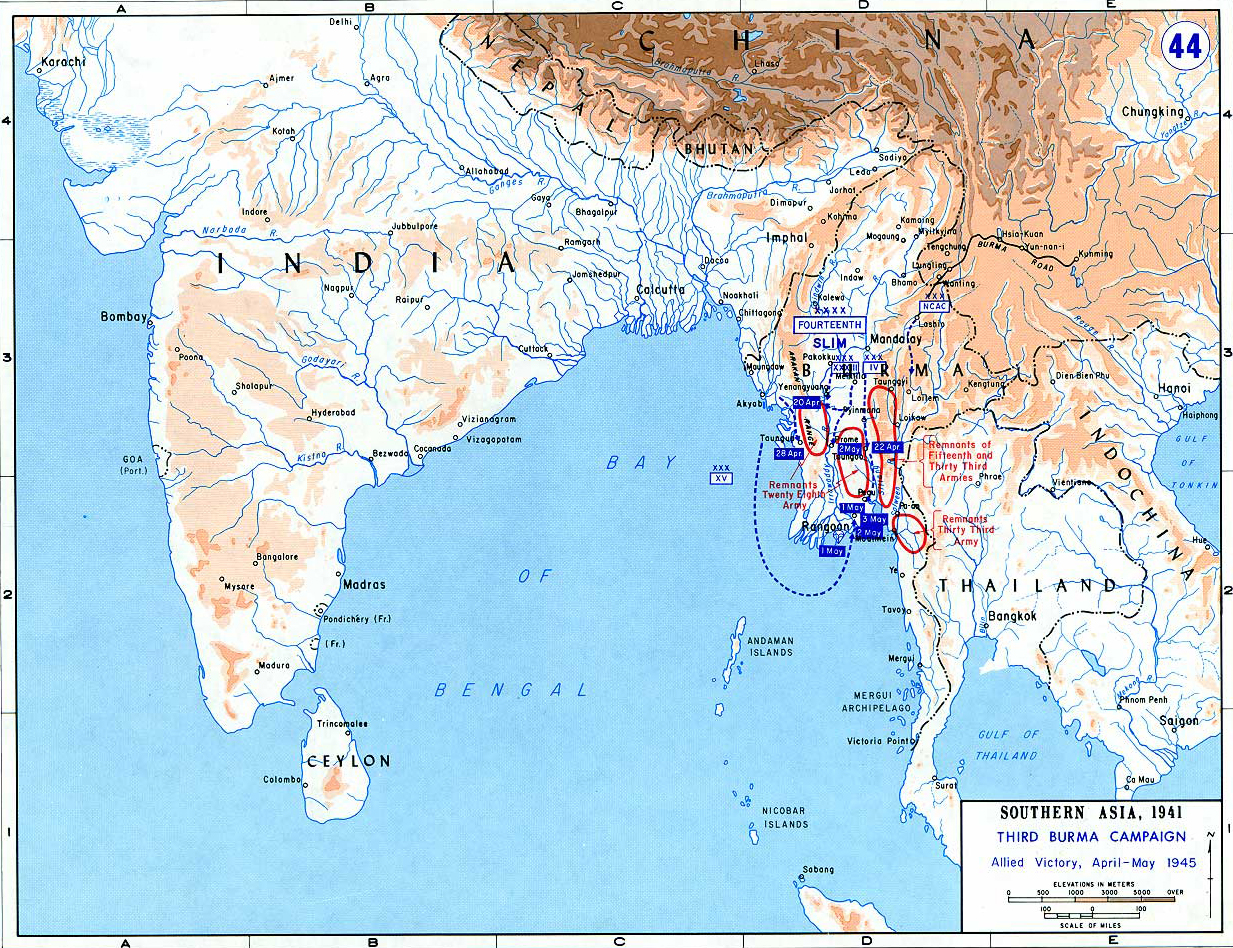Map Description
History Map of WWII: Burma Campaign 1945
Illustrating:
Allied Victory, April - May 1945
The entire Burma Campaign was fought from 14 December 1941 - 13 September 1945, and was part of
both World War II
and the Second Sino-Japanese War.
In the final phase of the Burma Campaign (April–May 1945), Japanese forces in Burma collapsed, which culminated in the Allied
recapture of Rangoon and the disintegration of Japan’s defensive lines.
In detail:
:: Japanese Army Remnants ::
Fifteenth and Thirty-Third Armies:
By April 1945, these units were trapped in a thin, north-south strip east of the Irrawaddy River. Isolated and undersupplied,
they faced relentless pressure from Allied advances.
The Thirty-Third Army was confined to a shrinking pocket in south-eastern Burma, unable to reinforce or
retreat effectively.
The Fifteenth Army remnants, decimated after the failed Imphal-Kohima offensive, were scattered in the Pegu Yomas hills,
attempting to regroup.
:: Allied Forces and Movements ::
Slim’s Fourteenth Army:
Positioned around Kalewa on the Chindwin River by late April, Slim’s forces advanced southeast toward Rangoon.
The IV Corps (around Mandalay) and XXXIII Corps (near Pakokku) executed pincer movements to cut off Japanese retreat routes.
20 April 1945: IV Corps launched a rapid thrust south along the Irrawaddy Valley, bypassing Japanese strongpoints.
The British XV Corps, commanded by Lt. Gen. Philip Christison, and subordinate to the Allied Twelfth Army under Gen. Montagu
Stopford, executed the amphibious landing at Rangoon (Operation Dracula). On 3 May 1945 they entered Rangoon, finding
the city abandoned by Japanese forces, who had withdrawn days earlier eastward.
However, they engaged remnants of the Japanese 28th Army along the coast and in the Irrawaddy delta.
3 May 1945: Allied troops entered Rangoon
Northern Combat Area Command (NCAC):
The NCAC, including Chinese and U.S. forces, secured Lashio by April, reopening the Burma Road to supply China. This
severed Japanese supply lines to the Thirty-Third Army.
Twelfth Army (South Burma):
British and Indian units under the Twelfth Army cleared southern Burma between Rangoon and Slim’s
advancing forces, mopping up isolated Japanese pockets.
:: Strategic Outcome ::
The campaign culminated in a decisive Allied victory, with Japanese forces suffering catastrophic losses. The British
Indian Army’s transformation—emphasizing mobility and combined arms—proved critical in overcoming rugged terrain and
entrenched defenses.
By May 1945, Allied control of Burma was secure, enabling a shift toward preparations for Malaya and Singapore.
Credits
Courtesy of the United States Military Academy Department of History.
Related Links
Map of the Burma Campaign 1943/44Map of the Burma Campaign: Slim's Offensive June 1944 - March 1945
WWII Timelines

